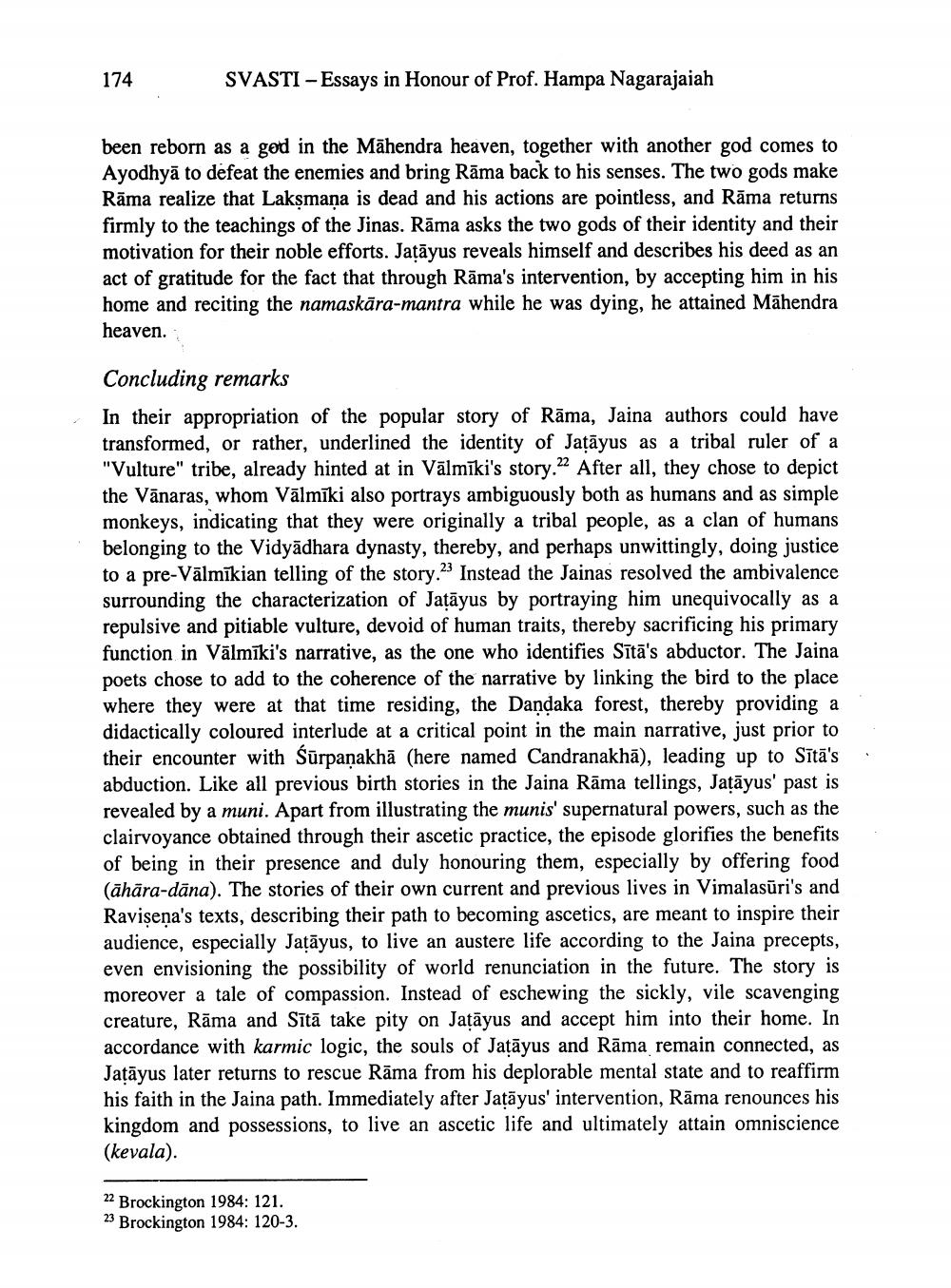________________
174
SVASTI - Essays in Honour of Prof. Hampa Nagarajaiah
been reborn as a god in the Māhendra heaven, together with another god comes to Ayodhyā to defeat the enemies and bring Rāma back to his senses. The two gods make Rāma realize that Laksmana is dead and his actions are pointless, and Rāma returns firmly to the teachings of the Jinas. Rāma asks the two gods of their identity and their motivation for their noble efforts. Jatāyus reveals himself and describes his deed as an act of gratitude for the fact that through Rāma's intervention, by accepting him in his home and reciting the namaskāra-mantra while he was dying, he attained Māhendra heaven.
Concluding remarks In their appropriation of the popular story of Rāma, Jaina authors could have transformed, or rather, underlined the identity of Jatāyus as a tribal ruler of a "Vulture" tribe, already hinted at in Vālmīki's story.22 After all, they chose to depict the Vānaras, whom Vālmīki also portrays ambiguously both as humans and as simple monkeys, indicating that they were originally a tribal people, as a clan of humans belonging to the Vidyadhara dynasty, thereby, and perhaps unwittingly, doing justice to a pre-Vālmīkian telling of the story.23 Instead the Jainas resolved the ambivalence surrounding the characterization of Jațāyus by portraying him unequivocally as a repulsive and pitiable vulture, devoid of human traits, thereby sacrificing his primary function in Vālmīki's narrative, as the one who identifies Sītā's abductor. The Jaina poets chose to add to the coherence of the narrative by linking the bird to the place where they were at that time residing, the Dandaka forest, thereby providing a didactically coloured interlude at a critical point in the main narrative, just prior to their encounter with Sūrpanakhā (here named Candranakhā), leading up to Sītā's abduction. Like all previous birth stories in the Jaina Rāma tellings, Jatāyus' past is revealed by a muni. Apart from illustrating the munis' supernatural powers, such as the clairvoyance obtained through their ascetic practice, the episode glorifies the benefits of being in their presence and duly honouring them, especially by offering food (āhāra-dāna). The stories of their own current and previous lives in Vimalasūri's and Ravisena's texts, describing their path to becoming ascetics, are meant to inspire their audience, especially Jatāyus, to live an austere life according to the Jaina precepts, even envisioning the possibility of world renunciation in the future. The story is moreover a tale of compassion. Instead of eschewing the sickly, vile scavenging creature, Rāma and Sītā take pity on Jatāyus and accept him into their home. In accordance with karmic logic, the souls of Jatāyus and Rāma remain connected, as Jatāyus later returns to rescue Rāma from his deplorable mental state and to reaffirm his faith in the Jaina path. Immediately after Jațāyus' intervention, Rāma renounces his kingdom and possessions, to live an ascetic life and ultimately attain omniscience (kevala).
22 Brockington 1984: 121. 23 Brockington 1984: 120-3.




